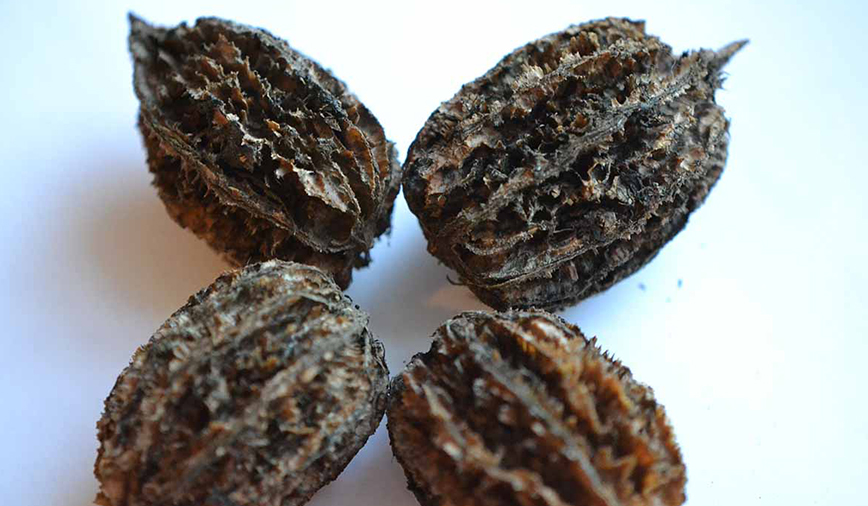Pam’s Perspective
From the…
Pam Otto is the Manager of Natural Programs and Interpretive Services for the St. Charles Park District
September 9, 2013
Don’t you hate it when you get a song stuck in your head?
For the past few weeks, I’ve had recurring bouts of that great Foundations hit, “Build Me Up Buttercup” popping into my brain at random, and sometimes inconvenient, times.
Don’t get me wrong, Buttercup is a great song. It’s catchy and infectious. But it also has a whole verse that I just can’t seem to get right, lyrics wise. That little hitch leads me to go back to the first verse, which leads back to the chorus of “…build me up, Buttercup…” over and over—and over– again.
What I couldn’t figure out was why the song kept coming to me. Until the other day.
I was pulling some buckthorn seedlings by the garage when I noticed it, lying on the ground beneath the remote keypad that I use almost daily. It clearly had been there for a while. Assorted twigs, grass clippings and other yard debris were scattered around it but the object itself was oddly untouched—all the better to insinuate itself into my brain subconsciously.
It was—not a buttercup—but a butternut.
So much for getting the words right.
The butternut, or Juglans cinerea, is a tree in the same genus as the black walnut, Juglans nigra. In fact, one of its other common names is white walnut, for the light color of its wood. The two trees do share several traits, but what’s interesting to me are their many differences.
For one, while black walnuts are ubiquitous, butternuts are rare. Susceptible to a canker disease that’s caused by a fungus with a 10-dollar name, Sirococcus clavigignenti-juglandacearum, the tree’s numbers have been reduced by as much as 80% in the states that comprise its home range
(eastern United States and southeast Canada). Along with Dutch elm disease and American chestnut blight, butternut canker often is dubbed one of our country’s greatest tree tragedies.
Another major difference lies in the trees’ structural components. In natural areas, where fire is used as a management tool, black walnuts are relatively resistant to the effects of high heat; their thick bark and strong heartwood protect them from damage and resulting decay. Meanwhile, butternuts do not tolerate fire well and frequently succumb if burned.
Dendrologists, naturalists and others who enjoy identifying trees by using characteristics other than leaves will quickly recognize black walnuts as the trees with the “monkey face” leaf scar; the point where the leaf is attached to the branch does indeed bear a strong resemblance to Curious George. For butternuts, though, that monkey face is enhanced by a band of hairs above its top edge. Imagine Curious George with a uni-brow and you’ll get the picture.
Then we have the butternut’s namesake fruit. Like its cousin the black walnut, the butternut’s nut is protected by a thick green husk. But unlike J. nigra, which bears round, smooth-coated fruit about the size of a handball, the butternut’s fruit is oblong in shape, hairy and sticky.
Inside, the nutshell is marked by deep furrows. The first time I saw one, I thought it was a peach pit on steroids. In fact, I still do. This most recent discovery was no different. Right before “Buttercup” took over, again, in my head, I had a fleeting thought of, “Wow, that is one giant peach pit! Er, butternut.”
Now, how the butternut came to be by my garage is another mystery. Perhaps a squirrel placed it there, opting to cache the nut in plain sight as opposed to burying it. That same individual may also be responsible for the black walnut, green husk still intact, cached in a quiet corner of my deck, and another placed on top of my grill’s propane tank.
But what doesn’t add up is the fact that there are no butternut trees in close proximity to my yard—at least not that I’ve been able to find.
The nearest one I’ve come across so far is more than two blocks away. A squirrel would need to be very determined to carry a nut that far before hiding it…in plain sight…
My other theory is that the butternut appeared, not from the mouth of a squirrel, but rather the beak of a crow. No slouches when it comes to planning ahead, crows frequently stash food for later consumption, often opting for tree forks and cavities. But I suppose, a secluded nook by a garage might do, in a pinch.
Further complicating matters, the butternut in question is not from this year’s crop. The green husk is long gone, and the nutshell is dry and weathered. But I know the nut was not in its current location a few months ago when I previously planted and weeded in that area; I’m guessing it arrived sometime in late June or early July.
I was about to give up and write the nut’s appearance off to some fluke of nature, or those who study it (items far stranger than nuts have fallen from my pockets). But then, Thursday night, I saw, through the dusty window of my laundry room…another butternut, cached in the corner of the outside sill.
Just when I was willing to let the butternut question subside, there it was, back again.
Why do you build me up (Build me up) Butternut, baby Just to let me down (Let me down) And mess me around…?
This one’s not over. Not by a long shot. Build me up, Butternut, don’t break my heart.
Pam Otto is the manager of nature programs and interpretive services at the Hickory Knolls Discovery Center, a facility of the St. Charles Park District. She can be reached at 630-513-4346 or potto@stcparks.org.

